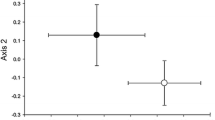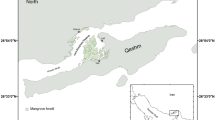Summary
The 13C/12C of limnephilid caddisfly larvae (Clistoronia magnifica) grown in the presence of red alder leaf particulate organic matter (POM) and alder leaf leachate was found to be identical to the 13C/12C of larvae grown on alder POM, but with isotopically contrasting grass leachate substituted for the above alder leachate. The isotopic similarity between these insects and the alder POM common in both treatments indicates that grass leachate was not a source of insect carbon. In contrast to these results, the 13C/12C of larvae grown on grass POM and leachate was markedly different from the 13C/12C of larvae raised on grass POM and alder leachate. The relative 13C depletion found in larvae from the latter treatment could be accounted for only if a significant amount of carbon derived from alder leachate had been incorporated into insect biomass. Significant differences in yield of insect biomass among the above treatments also were found.
Similar content being viewed by others
References
Anderson NH (1978) Continuous rearing of the limnephilid caddisfly, Clistoronia magnifica (Banks). In: Crichton MI (ed), Proceedings of the second international symposium on Trichoptera (1977). W Junk. The Hague p 317–329
Calder JA, Parker PL (1968) Stable carbon isotope ratios a indices of petrochemical pollution of aquatic systems. Environ Sci Technol 2:535–539
Craig H (1957) Isotopic standards for carbon and oxygen and correction factors for mass-spectrometric analysis of carbon dioxide. Geochim Cosmochim Acta 12:133–149
Dahm CN (1981) Pathways and mechanisms for removal of dissolved organic carbon from leaf leachate in streams. Can J Fish Aquat Sci (in press)
DeNiro MJ, Epstein S (1978) Influence of diet on the distribution of carbon isotopes in animals. Geochim Cosmochim Acta 42:495–506
Fenchel TM, Jørgensen BB (1977) Detritus food chains of aquatic ecosystems: the role of bacteria: In: Alexander M (ed) Advances in microbiology, Vol I. Plenum: New York p 1–58
Haines EB, Montague CL (1979) Food sources of estuarine invertebrates analyzed using 13C/12C ratios. Ecology 60:48–56
Jørgensen BB (1976) August Putter, August Krogh, and modern ideas on the use of dissolved organic matter in aquatic environments. Biol Rev 51:291–328
Kinne O (1978) Marine Ecology, Vol IV Dynamics. Chichester: Wiley
Moeller JR, Minshall GW, Cummins KW, Petersen RC, Cushing CE, Sedell JR, Larson RA, Vannote RL (1979) Transport of dissolved organic carbon in streams of differing physiographic characteristies. Organic Geochemistry 1:139–150
Mopper K, Degens ET (1979) Organic carbon in ocean: nature and cycling. In: B Bolin, ET Degens, S Kempe, P Ketner (eds) The global carbon cycle. Wiley New York p 293–316
McConnaughey T, McRoy CP (1979) 13C label identifies eelgrass (Zostera marina) carbon in an Alaskan estuarine food web. Mar Biol 53:263–269
Rau GH (1980) Carbon-13/carbon-12 variation in subalpine lake aquatic insects: food source implications. Can J Fish Aquat Sci 37:742–746
Rau GH, Hedges JI (1979) Carbon-13 depletion in a hydrothermal vent mussel: suggestion of a chemosynthetic food source. Science 203:648–649
Rich PA, Wetzel RG (1978) Detritus in the lake ecosystem. Amer Nat 112:57–71
Saunders GW (1976) Decomposition in freshwater. In: JM Anderson and A Macfadyn (eds) The role of terrestrial and aquatic organisms in decomposition processes, p 341–373. Blackwell Oxford
Sepers ABJ (1977) The utilization of dissolved organic compounds in aquatic environments. Hydrobiologia 52:39–54
Sorokin YuI (1978) Decomposition of organic matter and nutrient regeneration. In: Kinne 501–616
Stephens GC (1981) The trophic role of dissolved organics. In: AL Longhurst (ed) Analysis of marine ecosytems. Academic London (in press)
Stewart MG (1979) Absorption of dissolved organic nutrients by marine invertebrates. Oceanogr Mar Biol Ann Rev 17:163–192
Stump RL, Frazer JW (1973) Simultaneous determination of carbon, hydrogen, and nitrogen in organic compounds. Nucl Sci Abs 28:746
Teeri JA, Schoeller DA (1979) δ13C values of an herbivore and the ratio of C3 to C4 plant carbon in its diet. Oecologia (Berl) 39:197–200
Thayer GW, Parker PL, LaCroix MW, Fry B (1978) The stable carbon isotope ratio for some components of an eelgrass, Zosteta marina, bed. Oecologia (Berl) 35:1–12
Wangersky PJ (1978) Production of dissolved organic matter. In: Kinne 115–220
Williams PJ le B (1975) Biological and chemical aspects of dissolved organic material in sea water. In: JP Riley and G Skirrow (eds) Chemical oceanography. Academic London p 301–363
Author information
Authors and Affiliations
Rights and permissions
About this article
Cite this article
Rau, G.H., Anderson, N.H. Use of 13C/12C to trace dissolved and particulate organic matter utilization by populations of an aquatic invertebrate. Oecologia 48, 19–21 (1981). https://doi.org/10.1007/BF00346983
Issue Date:
DOI: https://doi.org/10.1007/BF00346983




